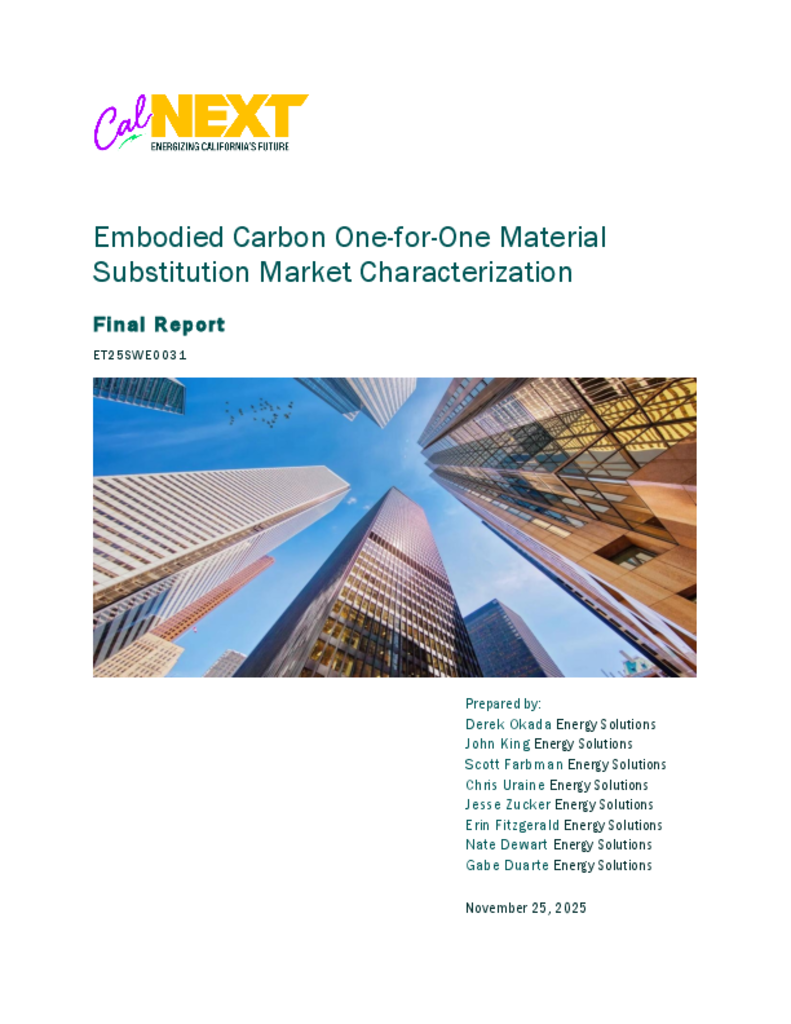ET25SWE0031 - Embodied Carbon One-for-One Material Substitution Market Characterization
Historically, energy efficiency (“EE”) programs have focused on addressing operational energy use and emissions. As California successfully reduces carbon from operational emissions through increased renewable energy sourcing, EE, and electrification, embodied carbon (“EC”) will become an increasing share of the remaining carbon emissions in buildings. The materials used to construct and maintain buildings contribute significant greenhouse gas (“GHG”) emissions over the lifetime of a building and this concept is referred to as EC, defined by the California Energy Commission (“CEC”) as the GHG “resulting from the extraction, manufacturing, transportation, installation, maintenance, and disposal of building materials.
EC is a developing policy area which is increasing in focus on a statewide and national level. Utilities and jurisdictions across the country are developing voluntary and mandatory building codes and standards, incentive programs, and other policies to address carbon more holistically including a focus on EC. These include Massachusetts, Colorado, Washington, Minnesota, Oregon, and the cities of Vancouver, BC, San Francisco, Chicago, Los Angeles, New York, Boston, as well as others. Additionally, Mass Save has recently proposed in its 2025-2027 Energy Efficiency and Decarbonization Plan, the first EC incentive program in the country which compliments its existing EE and Building Decarbonization (“BD”) offerings such as heat pumps (See https://www.masssave.com/-/media/Files/PDFs/Mass-2025-2027-Energy-Efficiency-Decarbonization-Plan.pdf). This program outlines a programmatic pathway for harmonizing EE, BD and EC activities. Likewise, California has introduced legislation to address EC in SB 596 for cement production and AB 2446 and AB 43 to develop EC strategies and trading mechanisms while CALGreen continues to develop mandatorystandards to mitigate EC through procurement policies for public buildings. Yet, research on EC remains relatively limited, especially for California.
EC can be a complimentary policy and program pathway to EE and BD especially since it represents 13% of carbon in buildings. In order to address the state’s goal to achieve carbon neutrality by 2045 and net neutrality thereafter per AB 1279, EC will be a critical area to address. EC also shares a similar stakeholder base in new construction and major building rehabilitation projects as EE and BD stakeholders including architects, builders, general contractors and local jurisdictions. Additionally, stakeholders including the CEC, PG&E, SDG&E and the California Energy Design Assistance’s (CEDA’s) new construction program have expressed interest in EC and EC has also been an increasing topic among EE conferences including ACEEE, Getting to Zero, Energy Transition Coordinating Council (ETCC) Emerging Technology (ET) Summit and the US Green Building Council.
Some low-EC building products may also provide similar EE savings benefits as standard building products. For these reasons, EC is an important area to study in order to inform EE and BD measure and code development. Examples of products providing EE and EC co-benefits include appliances (such as Heating, Ventilation, and Air Conditioning, “HVAC”, equipment) and products and materials such as furniture and flooring which are replaced over the course of their effective useful lives (“EULs”). Anecdotal evidence also indicates that some market actors are incorporating these practices, called “one-for-one material substitution,” to reduce their buildings’ total carbon footprint. Additional evidence gathered by Energy Solutions’ Voice of the Customer (“VOC”) research identified that certain EC market actors may not incorporate EE when pursuing EC activities. This study will attempt to document these opportunities to harmonize EE and EC through the selection of building materials and/or incorporating EE during the EC design and/or building materials procurement stages via interviews with EC stakeholders. The study will also seek to answer whether low-EC building materials have an incremental price difference than standard procured materials.
Addressing embodied carbon in the built environment is critical given that embodied carbon today represents 11 percent of global greenhouse gas (GHG) emissions. Although embodied carbon is a fraction of building related emissions today, it is projected to increase to as much as 50 percent of GHG from buildings as operational carbon is mitigated through energy efficiency (EE) and building decarbonization (BD) programs. Addressing embodied carbon is necessary to achieve California’s 2030 goal of a 40 percent GHG reduction below 1990 levels and 2045 goal of carbon neutrality. While embodied carbon policy action has been initiated (e.g., CALGreen, Buy Clean California, Senate Bill 596, Assembly Bill 2446, and Assembly Bill 43), embodied carbon remains largely adjacent to, but disconnected from, EE and BD programs.
To better understand embodied carbon market dynamics in California, this market study attempts to document whether market activities for low-embodied carbon materials exist, if GHG reductions through material substitution could occur with low-to-no cost interventions, and to identify what the key barriers and market solutions are for reducing embodied carbon in California. Further, the study aims to highlight future policy and program considerations that may enable harmonization of embodied carbon and EE programmatic structures. The project team found that while low-embodied carbon is growing as a relevant goal for corporations, overall awareness of embodied carbon remains low. Knowledge of key low-embodied carbon tools and approaches such as environmental product declarations (EPDs) and material substitution are not yet widely understood or utilized. There is increasing consideration in codes and standards and policies. Embodied carbon can be a complementary program pathway to current EE and BD programs.

